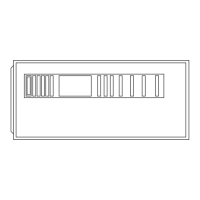d. Flame-Proving- When the burner flame is proved at the
flame-proving sensor electrode FSE, the furnace control
CPU begins the blower-ON delay period and continues to
hold the gas valve GV open. If the burner flame is not
proved within two seconds, the control CPU will close the
gas valve GV, and the control CPU will repeat the ignition
sequence for up to three more Trials-For-Ignition before
going to Ignition-Lockout. Lockout will be reset auto-
matically after three hours, or by momentarily interrupting
115 vac power to the furnace, or by interrupting 24 vac
power at SEC1 or SEC2 to the furnace control CPU (not at
W, G, R, etc.).
If flame is proved when flame should not be present, the
furnace control CPU will lock out of Gas-Heating mode
and operate the inducer motor IDM until flame is no longer
proved.
e. Blower-On Delay- If the burner flame is proven, the
blower motor is energized on HEAT speed 66 seconds (040
through 120 sizes) or 45 seconds (140 size) after the gas
valve GV is energized.
Simultaneously, the electronic air cleaner terminal EAC-1
is energized and remains energized as long as the blower
motor BLWM is energized.
f. Blower-Off Delay- When the thermostat is satisfied, the
R-to-W circuit is opened, de-energizing the gas valve GV,
stopping gas flow to the burners, and de-energizing the
humidifier terminal HUM. The inducer motor IDM will
remain energized for a 15-second (040 through 120 sizes)
or 5-second (140 size) post-purge period. The blower motor
BLWM and air cleaner terminal EAC-1 will remain ener-
gized for 90, 120, 150, or 180 seconds (depending on the
blower-OFF delay selection). The furnace control CPU is
factory-set for a 120-second blower-OFF delay.
COOLING MODE
The thermostat “calls for cooling.”
a. Single-Speed Cooling
(See Fig. 27, 50, 52, and 54 for thermostat connections)
The thermostat closes the R to G-and-Y circuits. The R to
Y circuit starts the outdoor unit, and the R to G-and-Y/Y2
circuits start the furnace blower motor BLWM on COOL
speed.
The electronic air cleaner terminal EAC-1 is energized with
115 vac when the blower motor BLWM is operating.
When the thermostat is satisfied, the R to G-and-Y circuits
are opened. The outdoor unit will stop, and the furnace
blower motor BLWM will continue operating on the
COOL speed for an additional 90 seconds. Jumper Y/Y2 to
DHUM to reduce the cooling off-delay to 5 seconds. (See
Fig. 31.)
b. Two-Speed Cooling
(See Fig. 27, 51, 53, 55, and 56 for thermostat connec-
tions.)
The thermostat closes the R to G-and-Y1 circuits for
low-cooling or closes the R to G-and-Y1-and-Y2 circuits
for high-cooling. The R to Y1 circuit starts the outdoor unit
on low-cooling speed, and the R to G-and-Y1 circuit starts
the furnace blower motor BLWM on low-cool speed (same
speed as FAN). The R to Y1-and-Y2 circuits start the
outdoor unit on high-cooling speed, and the R to G-and-
Y/Y2 circuits start the furnace blower motor BLWM on
COOL speed.
The electronic air cleaner terminal EAC-1 is energized
with 115 vac whenever the blower motor BLWM is
operating.
When the thermostat is satisfied, the R to G and-Y1 or R to
G and-Y1 and-Y2 circuits are opened. The outdoor unit
stops, and the furnace blower BLWM and electronic air
cleaner terminal EAC-1 will remain energized for an
additional 90 seconds. Jumper Y1 to DHUM to reduce the
cooling off-delay to 5 seconds. (See Fig. 31.)
THERMIDISTAT MODE
(See Fig. 50, 51, 52, and 53 for Thermidistat connections.)
The dehumidification output, DHUM on the Thermidistat
should be connected to the furnace control thermostat terminal
DHUM. When there is a dehumidify demand, the DHUM
input is activated, which means 24 vac signal is removed from
the DHUM input terminal. In other words, the DHUM input
logic is reversed. The DHUM input is turned ON when no
dehumidify demand exists. When 24 vac is initially detected
by the furnace control on the DHUM input, the furnace control
operates in Thermidistat mode. If the DHUM input is low or
OFF for more than 48 hours, the furnace control reverts back
to non-Thermidistat mode.
Notes For Figure 50-56
1. Heat pump MUST have a high pressure switch for dual fuel applications.
2. Refer to outdoor equipment Installation Instructions for additional information and setup procedure.
3. Select the “ZONE” position on the two-speed heat pump control.
4. Outdoor Air Temperature Sensor must be attached in all dual fuel applications.
5. Dip switch No. 1 on Thermidistat should be set in OFF position for air conditioner installations. This is factory default.
6. Dip switch No. 1 on Thermidistat should be set inON position for heat pump installations.
7. Dip switch No. 2 on Thermidistat should be set in OFF position for single-speed compressor operation. This is factory default.
8. Dip switch No. 2 on Thermidistat should be set in ON position for two-speed compressor operation.
9. Configuration Option No. 10 “Dual Fuel Selection” must be turnedON in all dual fuel applications.
10. NO connection should be made to the furnace HUM terminal when using a Thermidistat.
11. The RVS Sensing terminal “L” should not be connected. This is internally used to sense defrost operation.
12. DO NOT SELECT the “FURNACE INTERFACE” or “BALANCE POINT” option on the two-speed heat pump control board. This is
controlled internally by the Thermidistat/Dual Fuel Thermostat.
13. Dip switch D on Dual Fuel Thermostat should be set in OFF position for single-speed compressor operation. This is factory default.
14. Dip switch D on Dual Fuel Thermostat should be set in ON position for two-speed compressor operation.
40

